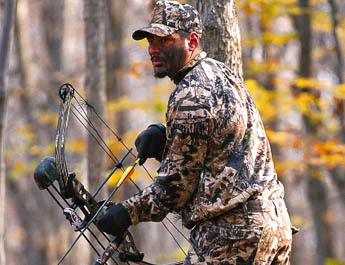There’s no doubt about it: Still-hunting is one of the toughest ways to punch a tag. Not only are a buck’s senses of smell and hearing more acute than ours, but his sense of sight has evolved into a veritable radar detector when it comes to objects in motion. One false move, and your buck of a lifetime will vanish without a trace.
Nonetheless, patient nimrods manage to get the drop on a racked buck or two each fall simply by sneaking along through the woods “Indian style.” Here’s how they do it.
1. STICK TO THE SHADOWS
The first step is to learn to stay out of sight. Stick to the shadows whenever possible, and get into the habit of using available ground cover and land contours, such as dry creek beds and even stone walls, to help conceal your forward progress.
Except for your blaze-orange hunting requirements, all outerwear and underclothing should be dark or camouflaged, including your hat if the law allows. Before you step into the woods, smear your face, neck and ears with bowhunter’s “war paint.” A shiny face is a dead giveaway.
2. MAPS AND MORE MAPS
The second step is learning the lay of the land. Topographical maps, aerial photographs, road maps and plenty of shoe leather will put you on intimate terms with your whitetail hot spot before the season opener. It’s a good idea to first use a topo map to locate natural features that may promote deer travel, such as steep ravines, ridges, saddles, swamps and large bodies of water. Then check them out for deer sign personally.
Adirondack guide Mark Eddy scouts beech ridges for stands of mast and old apple orchards marked on topo maps. “I like to be in these places early in the morning and again late in the afternoon to learn the direction of prevailing winds and to ask myself how a buck might enter and exit these food sources undetected.”
** 3. HUMAN SCENT**
Knowing your hunting turf like the back of your hand can also help you with scent control. How? You won’t be spreading your human odor to the four winds as you wander aimlessly about the woods in search of a racked buck. Instead, you’ll be stalking downwind or crosswind of known concentrations of deer.
Plan each day’s hunt only after you’ve ascertained the wind direction. Tie a feather or thread to your gun to keep tabs on subtle changes, and be prepared to change game plans if variable winds foil your original strategy.
[pagebreak] OF NOISE”] 4. THE RIGHT KIND OF NOISE
We all know that unnatural sounds can send a big buck farther into the hills, but at other times the breaking of a branch or the scuffling of feet no more alarms a buck than a distant airplane passing overhead. The difference is often in the perceived cadence. The next time you’re in the woods, take a moment and just listen. All kinds of animals make noises, especially in the dim hours when they’re feeding or traveling about. Man’s gait is more purposeful, however. That’s because his steps are both equidistant and unidirectional. When I still-hunt, I try to imitate the muted sounds of a feeding whitetail. If I trip or snap a twig, I’ll blow once on my grunt tube and then remain motionless until things return to normal.
5. THE “EYES” HAVE IT
The real trick to still-hunting is learning to move forward with both of your eyes always glued to the cover ahead. First, look down briefly and locate an unobstructed passageway. Then, as you scan the terrain in front of you, take one or two steps along this route without looking down. There will now be a whole new vista to examine; do so carefully, using your field glasses (not your gun scope). Soon, you’ll find yourself moving quietly, like a deer feeding on beechnuts, and at the right rate of speed-not too fast and not too slow. It’s important that you don’t let your footfall become an unnatural sound in the woods.
And remember,, your eyes must be searching for deer.
** 6. TIMING IS EVERYTHING**
Next you must be in the right place at the right time. This takes not only a thorough knowledge of your hunting territory, but also a keen awareness of whitetail deer behavior. For example, one of the best places to still-hunt during the early season is alongside and downwind of a deer trail that leads from a bedding area to a feeding location.
As the rut unfolds, however, my favorite spot to be is downwind of a fresh scrape line. If you examine the tracks and debris surrounding the scrapes, you should be able to figure out when and from what direction you can expect the buck to return. Then stay parallel and keep the wind in your favor as you still-hunt very slowly toward the incoming buck.
This is a hot setup that works with either a bow or a gun. My best bucks to date include a Pope and Young 9-pointer I arrowed at 30 yards and a 220-pound-dressed 10-pointer I shot with a rifle at 22 feet.
7. FIREPOWER
The ideal still-hunting rifle is one that is light enough to carry all day, short enough to allow for quick handling in brushy terrain and powerful enough to drop a 300-pound whitetail at 100 yards. Most still-hunters I know opt for a low-power scope in the 1.5 to 5X class. Peep sights are also popular, but some still-hunters will fit their carbines with both a peep sight and a scope with see-through mounts, which comes in handy on those bad-weather days out in the field.

